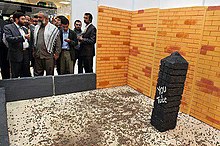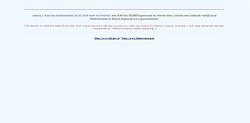Censorship of YouTube
[2][3] YouTube's Terms of Service prohibit the posting of videos which violate copyrights or depict pornography, or those which promote racism, illegal acts, gratuitous violence, or hate speech.
[18] On September 12, 2012, YouTube was blocked in Afghanistan due to hosting the trailer to the controversial film about Muhammad, Innocence of Muslims, which the authorities considered to be blasphemous.
[21][22] In March 2009, YouTube was blocked in Bangladesh after a recording of an alleged meeting between the prime minister and army officers was posted revealing anger by the military on how the government was handling a mutiny by border guards in Dhaka.
[29] In June 2007, a judge ordered Cicarelli and her boyfriend to pay all court and lawyer costs, as well as R$10,000 (roughly US$3,203) to the three defendants—YouTube, Globo, and iG, citing a lack of good faith in pushing the privacy case when their actions took place in public.
[30] On December 13, 2024, a survey by the Observatory of the Disinformation Industry and Gender Violence on Digital Platforms identified 137 channels with misogynistic content on YouTube in Brazil.
[40] The Article 17 of the Directive on Copyright in the Digital Single Market is feared and criticized as censorship, mandatory for all countries of the European Union within two years if adopted.
[41][42][43] On April 1, 2008, Indonesian information minister Mohammad Nuh asked YouTube to remove Fitna, a controversial film made by Dutch right-wing politician Geert Wilders.
[56] Pakistan Telecom had broadcast to other ISPs in the Pacific Rim the false claim that it was the correct route for the addresses in YouTube's IP space.
[57] It was suggested by some Pakistani websites, blogs, and by electoral process watchdog groups at the time that the block was imposed largely to distract viewers from videos alleging vote-rigging by the ruling MQM party in the February 2008 general elections.
[63] Bytes for All, a Pakistani non-profit organization, filed a constitutional challenge to the ban through their counsel Yasser Latif Hamdani in the Lahore High Court.
[70] On November 25, 2017, the NetBlocks internet measurement platform and Digital Rights Foundation collected evidence of nationwide blocking of YouTube alongside other social media services, imposed by the government in response to the violent Tehreek-e-Labaik protests.
[71][72][73] The technical investigation found that many, but not all, major Pakistani fixed-line and mobile service providers implemented the YouTube restriction which was lifted by the PTA the following day when protests abated after the resignation of Minister for Law and Justice Zahid Hamid.
[75] On July 28, 2010, a court in the city of Komsomolsk-on-Amur ordered a local ISP to block access to youtube.com, web.archive.org, and several other websites offering books for downloads, citing extremist materials as the reason.
[77] On September 4, 2017, Roskomnadzor announced their intention to delete a video released by a popular YouTube channel Nemagia in which bloggers Alexey Pskovitin and Mikhail Pecherskiy described unscrupulous business strategies by Tinkoff Bank.
[78] In February 2019, as a result of a complaint received by Roskomnadzor, YouTube has demanded that the Ukrainian Centre for Journalist Investigations remove a video about Emir-Usein Kuku, a Crimean Tatar 'human rights defender' who has been arrested by Russian authorities in 2016.
[79] In September 2021, YouTube blocked two German-language channels run by a Russian state-backed media company RT stating they spread misinformation about COVID-19 vaccines.
[99] In 2013, Tajikistan blocked YouTube for a third time because of a video which depicts President Rakhmon dancing and singing out of tune at his son's wedding party in 2007.
[103] On May 23, 2019, after the President of Tajikistan criticized the internet for "bolstering terrorism", Tajik authorities extended the blockages of all Google resources, including YouTube.
[106] Although no official explanation was given for the ban, many bloggers believed the reason for the blocking was a video of former Prime Minister Thaksin Shinawatra's speech on CNN.
[113] On September 21, 2007, Thai authorities announced they were seeking a court order to block videos that had appeared on YouTube accusing Privy Council president Prem Tinsulanonda of attempting to manipulate the royal succession to make himself Thailand's king.
[118] This first occurred when Türk Telekom blocked the site in compliance with decision 2007/384 issued by the Istanbul 1st Criminal Court of Peace (Sulh Ceza Mahkeme) on March 6, 2007.
"[126] In June 2010, President Abdullah Gül used his Twitter account to express disapproval of the country's blocking of YouTube, which also affected access from Turkey to many Google services.
This time, they did so many hours after a video was posted there claiming to depict Turkey's foreign minister, spy chief, and a top general discussing scenarios that could lead to their country's military attacking jihadist militants in Syria.
[135] On April 6, 2015, YouTube was again briefly blocked, alongside Facebook and Twitter, due to the widespread posting of footage of a prosecutor killed during a hostage crisis.
[137][138] On July 1, 2020, in a statement made to his party members, Erdoğan announced that the government would introduce new measures and regulations to control or shut down social media platforms such as YouTube, Twitter and Netflix.
[139] The UAE's Telecom Regulatory Authority (TRA) briefly blocked YouTube from August to October 2006 due to increasing concerns regarding the presence of adult content in the website.
[146][147] During the Venezuelan presidential crisis of 2019, YouTube has been heavily censored regularly by Venezuela's state-owned internet service provider, CANTV.
The blocking of YouTube and social media websites by the Venezuelan government were intended to suppress information relating to Juan Guaidó and the pro-opposition National Assembly.
[148][149][150][151][152] On January 21, 2019, the day of a Bolivarian National Guard rebellion in the Cotiza neighborhood of Caracas, internet access to some social media websites, including YouTube was reported to be blocked for CANTV users.
[157][158] The YouTube live stream of the press conference of US Secretary of State Mike Pompeo and Colombian President Iván Duque Márquez on April 15, 2019, was disrupted for CANTV users.


